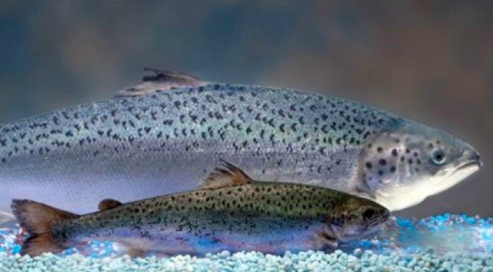
AquaBounty Salmon Behind Atlantic Salmon of Same Age
For the first time, the Food and Drug Administration has determined that genetically engineered (GE) AquaAdvantage salmon are safe to eat — that their genetic modifications are safe for the fish and thus for humans too. The FDA also found that the claims about the rapid growth of the fish are also true and also will not cause harm to humans. What is the genetic modification that allows these fish to grow to maturity in half the time? As FDA explains in its announcement, these fish have a DNA that is a mixture of “the growth hormone gene from Chinook salmon” and a gene sequence from another type of fish called an “ocean pout,” which is an eel-like fish, and this combination of genes gives these salmon the ability to grow “much faster than non-GE, farm-raised Atlantic salmon.”
- This could mean big business for Aqua Bounty, the company that will produce the AquaAdvantage salmon, which is planning to raise the salmon in a plant in rural Indiana as soon as it gets its final permits for the facility.
- When fully grown in about 18 months, these GE fish will weigh about 10 pounds so they would hit the market in the fall of 2020.
- Nearly 100 percent of the salmon consumed in the U.S. is imported — approximately 350 million tons to be exact — and most is farm-raised not wild caught these days.
- The FDA says these fish will NOT be grown in pens in the ocean so there is no risk of them escaping and ruining wild stocks. Their eggs are grown in Canada and then imported into the U.S. and sent to the company’s “grow out” facility to be raised until they are big enough to eat.
- The new GE salmon must be labeled as such when sold in the U.S. Congress had prevented its sale here until the labeling requirements were set. Now that they are, the FDA could life the ban.
The CEO of the company producing the AquaAdvantage salmon said in a statement, “FDA’s actions will allow for production and sale to begin here in the U.S., bringing opportunity for investment in rural America, creating American jobs, while also reducing dependence on seafood imports.” Wild Atlantic Salmon is “commercially extinct” in the U.S. and an endangered species. There is a lawsuit pending against the sale of the GE salmon — it was brought by a coalition of consumer, environmental, and fishing groups.
Why This Matters: The first GMO fish to be OK’d for production and sale in the U.S. is a big deal. It is a major step forward for domestic aquaculture. On the good news side, there is no risk of those Hoosier salmon escaping into the ocean so the wild salmon are safe. And so is the ocean safe from the fish waste, excess nutrient loading, and disease that are the byproducts of salmon farmed in the ocean. Much of the fish we eat now is not raised in the U.S. where safety standards are high. Right now it is hard for consumers to know that the wild fish that they purchased was harvested sustainably, and as we reported yesterday, the fish you are eating may not be what you think it is. As long as it is labeled, then it is the consumer’s choice.
To Go Deeper into GE Salmon: You can read these Nine Thing You Need To Know About GMO Salmon from GMOAnswers.com.
March 12, 2019 » FDA, Frankenfish, GMO, Salmon


